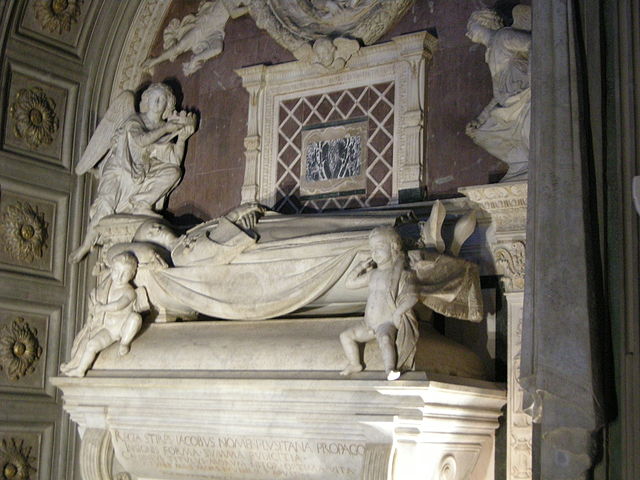Loading AI tools
Bishop of Arras and of Paphos From Wikipedia, the free encyclopedia
Jaime or James of Portugal (17 September 1433 – 27 August 1459), also known as James of Coimbra, James of Lusitania, was a Portuguese infante (prince) of the House of Aviz, and a bishop and cardinal of the Roman Catholic Church.
| James of Coimbra | |
|---|---|
| bishop of Arras and of Paphos | |
 Coat of Arms of James of Portugal, combining his father coat of arms (Aviz-Coimbra) with his mother's (Aragon). | |
| archbishop of Lisbon | |
| Born | 17 September 1433 |
| Died | 27 August 1459 |
| House | Aviz |
| Father | Peter, Duke of Coimbra |
| Mother | Isabella of Urgell |
| Religion | Roman Catholicism |
James was the 3rd son of Infante Pedro, Duke of Coimbra, and Isabella of Urgell; among other kinships he was the great-grandson of the English prince John of Gaunt.
At the age of 15, James accompanied his father in the Battle of Alfarrobeira in 1449. During the conflict, his father's forces were defeated by the Portuguese royal army, and his father was killed.[1] After the battle, James was taken captive but was later freed as a result of the intervention of his aunt Isabella and her husband Duke Philip the Good of Burgundy.[2] He then went into exile in Burgundy together with his brother John and his sister Beatrice. His aunt ensured that the siblings were well provided for.[3]
James of Portugal studied in Flanders and, on 23 March 1453, was appointed Bishop of Arras. On his aunt’s advice, he traveled to Rome, where Pope Nicholas V, hearing of the disgraces inflicted upon his family after Alfarrobeira, resolved to appoint the young James as the new Archbishop of Lisbon, which had been recently vacated by the death of D. Luís Coutinho. However, not being old enough to be consecrated to the dignity, James was only appointed administrator in perpetuity of the Archdiocese on 30 April 1453. Given the political situation in Portugal, James was unable to return to Lisbon to take possession of it, and so remained in Italy and governed his archdiocese from afar, via the vicar-general Luís Anes.[citation needed]
Nicholas V having died in early 1455, the new Pope Calixtus III elevated James to a cardinal-deacon of the Church (despite not having the requisite 30 years of age for the office), assigning him the titular diaconate of Santa Maria in Portico Octaviae, soon substituted for the diaconate of Sant'Eustachio. Callixtus III also gave James the Bishopric of Paphos,[citation needed] in Cyprus, where his brother, John, had married Charlotte of Lusignan, Princess of Cyprus.
Following the death of Callixtus III, James of Portugal participated in the conclave that elected Pius II as the new pope.[citation needed] He was appointed a Knight of the Order of the Golden Fleece, number 58, at the 9th Chapter of the order, held in 1456 at The Hague.
The Portuguese art historian António Bélard da Fonseca, in his multi-volume O Mistério dos Painéis (1957-1967), controversially claimed that it is James of Portugal, and not St. Vincent, who is depicted as the radiant saintly figure in the central panels of the famous Saint Vincent Panels of Nuno Gonçalves.

While travelling from Rome to Austria to rally support for a new crusade, James of Portugal fell ill and died in Florence on 27 August 1459, at the age of twenty-six.[4] He was buried in the basilica of San Miniato al Monte in Florence, the only tomb in that church.[5] Some of the best artists in Renaissance Florence were commissioned to design and decorate the chapel of the "Cardinale del Portogallo" in San Miniato, including the Cardinal of Portugal's altarpiece by the Pollaiuolo brothers.
| Ancestors of James of Portugal | |||||||||||||||||||||||||||||||||||||||||||||||||||||||||||||||||||||||||||||||||||||||||||||||||||||||||||||||||||||||||||||||||||||||||||||||||||||||||||||||||||||||||||||||||||||||||||||||||||||||||||||||||||||||||||||||||||||||||||||||||||||||||||||||||||||||||||||||||||||||||
|---|---|---|---|---|---|---|---|---|---|---|---|---|---|---|---|---|---|---|---|---|---|---|---|---|---|---|---|---|---|---|---|---|---|---|---|---|---|---|---|---|---|---|---|---|---|---|---|---|---|---|---|---|---|---|---|---|---|---|---|---|---|---|---|---|---|---|---|---|---|---|---|---|---|---|---|---|---|---|---|---|---|---|---|---|---|---|---|---|---|---|---|---|---|---|---|---|---|---|---|---|---|---|---|---|---|---|---|---|---|---|---|---|---|---|---|---|---|---|---|---|---|---|---|---|---|---|---|---|---|---|---|---|---|---|---|---|---|---|---|---|---|---|---|---|---|---|---|---|---|---|---|---|---|---|---|---|---|---|---|---|---|---|---|---|---|---|---|---|---|---|---|---|---|---|---|---|---|---|---|---|---|---|---|---|---|---|---|---|---|---|---|---|---|---|---|---|---|---|---|---|---|---|---|---|---|---|---|---|---|---|---|---|---|---|---|---|---|---|---|---|---|---|---|---|---|---|---|---|---|---|---|---|---|---|---|---|---|---|---|---|---|---|---|---|---|---|---|---|---|---|---|---|---|---|---|---|---|---|---|---|---|---|---|---|---|---|---|---|---|---|---|---|---|---|---|---|---|---|---|---|---|
| |||||||||||||||||||||||||||||||||||||||||||||||||||||||||||||||||||||||||||||||||||||||||||||||||||||||||||||||||||||||||||||||||||||||||||||||||||||||||||||||||||||||||||||||||||||||||||||||||||||||||||||||||||||||||||||||||||||||||||||||||||||||||||||||||||||||||||||||||||||||||
Seamless Wikipedia browsing. On steroids.
Every time you click a link to Wikipedia, Wiktionary or Wikiquote in your browser's search results, it will show the modern Wikiwand interface.
Wikiwand extension is a five stars, simple, with minimum permission required to keep your browsing private, safe and transparent.